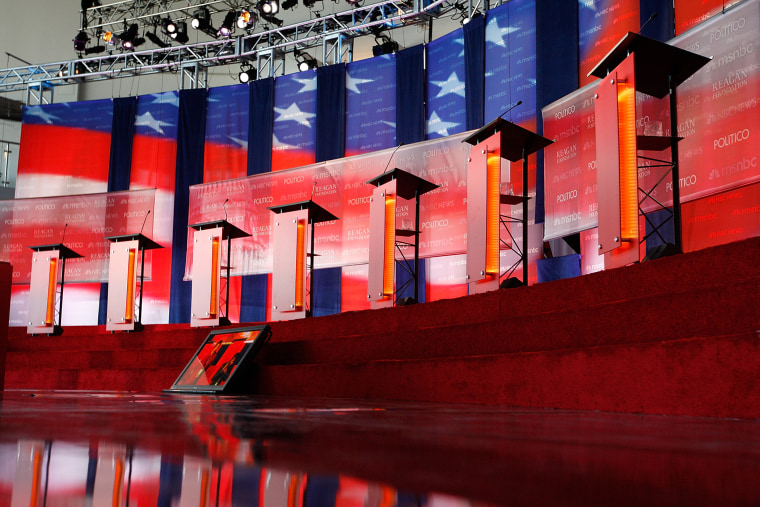Largely out of view, executives and journalists from Fox and CNN, with input from the national party, are weighing the entrance criteria for the first two debates. Among the options being considered is using polling as a rough inclusionary test, followed by a fundraising metric -- dollars raised or the number of individual donors activated. All of these things are in flux as the networks and the national party struggle with the largest plausible debate field in history. "This is truly historic in that normally you are trying to get people into the debates and now you are trying to whittle people out of the debates," said one Republican operative familiar with the debate process. "You've never had more than 10 candidates in either party on a debate stage. You could get to at least 16 to 17 candidates and make a legitimate case for them being there -- easy."
Biggest. Field. Ever.
With 22 possible Republican presidential candidates, the question is hard to avoid: why is the GOP's 2016 field so enormous?

Earlier this year, the Republican National Committee unveiled a schedule of party-approved primary debates for the 2016 presidential race. Between August and February, GOP candidates will meet for nine debates, a third of which will be hosted by a Fox network. (The Democratic National Committee unveiled its smaller debate schedule today.)
Almost immediately, however, a problem emerged: how exactly are Republicans going to hold debates for the largest field of candidates in American presidential history? Zeke Miller reported yesterday on the challenge, which relevant players are still working on.
That's actually a fairly conservative number. I'd say there are probably 14 candidates likely to compete for the Republican nomination: Jeb Bush, Scott Walker, Rand Paul, Ted Cruz, Mike Huckabee, Marco Rubio, Ben Carson, Chris Christie, Rick Perry, John Kasich, Rick Santorum, Lindsey Graham, Bobby Jindal, and Carly Fiorina.
We can probably add two former governors -- James Gilmore and George Pataki -- to the mix, along with John Bolton and Donald Trump. That's 18.
Two current governors -- Mike Pence and Rick Snyder -- certainly seem interested, as does former Gov. Bob Ehrlich. Peter King has publicly talked up the possibility, too, bringing us to a total of 22, enough to hold an 11-on-11 football scrimmage.
All of this, of course, leads to some practical questions, including who gets to participate in debates, but there's also an overarching question: why in the world is the Republican field so big?
There's probably no single explanation, but a combination of factors:
* No GOP frontrunner: Jeb Bush hoped a "shock and awe" fundraising campaign would help clear the GOP field, just as his brother did in 1999 and 2000. That clearly hasn't happened. On the contrary, at this stage, there arguably is no GOP frontrunner -- a historical oddity in Republican politics in the modern era -- which only helps encourage a larger field.
* Pent-up demand: Some of these candidates -- Huckabee, Christie, et al -- took a good, long look at the 2012 race before delaying their plans, in part because of Mitt Romney's advantage, in part because it's tough to beat an accomplished incumbent when the economy is improving. But the weakness of the 2012 field helps explain the size of the 2016 field -- those who took a pass last time are now eager to seize their last real opportunity.
* The GOP is "due": Democrats won in 2008 and 2012, but winning three in a row is awfully difficult, and each party has only done it only once since WWII. With this history in mind, every ambitious Republican sees the 2016 race as a rare opportunity: winning the nomination in a primary contest with no frontrunner gives them a pretty good chance of becoming the next president of the United States.
* These folks have nothing better to do: Most of the 22 candidates listed above have no current day job to speak of, and most are "former" governors, senators, ambassadors, CEOs, neurosurgeons, etc. Others are current senators who aren't using their seats to do much legislating anyway. They can all freely run for president because they have plenty of free time.
* "Wingnut welfare": A phrase made popular by Paul Krugman points to a real phenomenon in conservative politics: there's a far-right infrastructure in place that offers financial security for prominent figures. This, as much as anything, encourages Quixotic presidential campaigns, because candidates realize that failure is often little more than a precursor to years of success. Half-way competent Republicans who raise their national profile can expect a Fox News gig, a radio show, a print column, paid speaking gigs, book deals, a lucrative mailing list, and possibly even a leading role in prominent activist groups.
Given all of these factors, each playing out at the same time, is it really that surprising to see the largest field in American history?